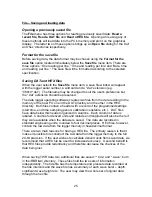
25
File – Saving and loading data
Opening a previously saved file
The
File
menu has three options for reading previously saved data:
Read a
recent file, Read a DAT file
and
Read a HEX file.
Opening a file using any of
these methods will load data into the PC's memory and plot it on the graphical
display
.
The latter two of these options brings up an
Open file
dialog for the 'dat'
and 'hex' directories respectively.
Format for the save file
Before saving data, the data format may be chosen using the
Format for the
save file
option located immediately below the
Save file
menu item. There are
three options: 'One reading per line,' 'Time and reading per line' and 'Date, time
and reading per line.' The save file will be formatted according to the selected
specification.
Saving DAT and HEX files
When the user selects the
Save file
menu item, a save file window will appear
with the logger serial number, a wild card and a “.dat” extension (e.g.
“08910*.dat”). The filename may be changed to suit the user's preference but
the “.dat” extension should be preserved.
The data logger operating software creates two files from the data residing in the
memory of the host PC: one in the DAT directory and the other in the HEX
directory. Both files contain a header with a record of the programmed settings
(start time, end time, sampling period, calibration constants, etc.). DAT files
have data below this header organized in columns. Each column of data is
labeled. Columns for derived units and latitude and longitude will also be there if
they were available when the data were saved. The data are recorded in
standard engineering units, rounded to four decimal places. HEX files, however,
contain the raw data from the logger memory in hexadecimal format.
There are two main reasons for having a HEX file. The primary reason is that it
makes it possible to reconstruct the raw data from the logger memory to the full
24-bit precision. If the user wishes to calculate derived units from saved data, we
recommend that a HEX file be used for increased accuracy. A second benefit is
that HEX files provide redundancy and therefore decrease the chances of the
data being lost.
When saving TWR data, two additional files are saved: “*.tide” and *.wave”, both
in the \RBR\twr\ directory. These files hold the two sets of information
independently. The tide file has the temperature and pressure data recorded at
the tide intervals and the wave file has a summary of each wave burst – depth,
significant wave height etc. The user may view the whole set of original data
through the hex file.
















































